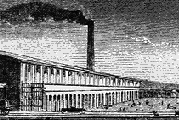|
The equilibrium in the Cass-Koopmans model gives us a constant consumption per capita and capital-labor ratio. This, as we noted, is not necessarily consistent with stylized empirical facts about the growth of industrialized economies. Like the Solow-Swan model, some form of technical progress may be called for to accommodate increasing consumption per capita over time. As in the Solow-Swan model, the simplest procedure is to incorporate exogenous Harrod-neutral or labor-augmenting technical progress, so that Y = F(K, AL), where A is the technical "shift" factor, where A ³ 1 and dA/dt > 0. So, let us have it that technical progress proceeds at a constant, exogenous rate, i.e. (dA/dt)/A = q . As James Mirrlees (1967) demonstrated, modifying the Cass-Koopmans model to accommodate Harrod-neutral technical progress is a simple matter of rewriting the entire thing in terms of effective labor units, AL. So, k = K/L gets converted to ke = K/AL, y =¦(k) gets converted to Y/AL = ye = ¦(ke), consumption per capita, c = C/L, gets converted to ce = C/AL, and so on. The social planner's problem, thus converted, becomes:
which is effectively identical to before, except now with effective labor units and with the constraining differential equation, q is incorporated as a scaling factor. Setting up the Hamiltonian, etc., we achieve the analogous solution:
which is qualitatively the same as before. The solution will be a saddlepoint stable, etc., and the diagramatic representation will be as in Figure 3, in (ce, ke) space. The optimal path will be to jump onto the stable arm and approach the steady-state (ce*, ke*). Notice that while consumption per effective capita, ce = C/AL is constant, consumption per capita, c = C/L, is growing at the rate q (as is the capital-labor ratio, k, and the output-labor, y, ratio). Thus, all this is exactly as we had when we added technical progress in Solow-Swan. The only significant difference in this context is that the dc/dt = 0 isokine will lie where ¦¢(ke) = r + q . As it is easy to prove that ¦ ¢ (ke) = ¦ ¢ (k), then this implies that adding technical progress makes it such that the equilibrium rate of return on capital, ¦ k, will be r +q , which is higher than before (where it was just r ), and so the steady-state capital-effective labor ratio ke* will be lower.
|
All rights reserved, Gonçalo L. Fonseca

